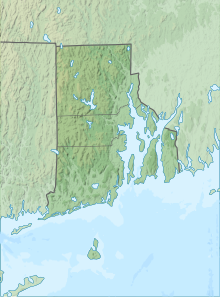| Great Swamp Massacre | |||||||
|---|---|---|---|---|---|---|---|
| Part of King Philip's War | |||||||
 A painting of the Great Swamp Massacre | |||||||
| |||||||
| Belligerents | |||||||
|
New England Confederation Pequots Mohegans | Narragansetts | ||||||
| Commanders and leaders | |||||||
|
Governor Josiah Winslow (Commander-in-chief)[1] Major Samuel Appleton (Massachusetts Bay Colony commander)[1] Governor Robert Treat (Connecticut Colony commander)[1] Major William Bradford (Plymouth Colony commander)[1] Uncas (Mohegan Sachem) Captain William Raymond[2] | Canonchet (Narragansett Sachem) | ||||||
| Strength | |||||||
|
1,000 militia 150 warriors |
1,000 warriors 1 fort | ||||||
| Casualties and losses | |||||||
|
~70 killed ~150 wounded |
~ 97 warriors killed ~300–1,000 non-combatants killed[3] ~300 captured 1 fort destroyed[4] | ||||||
Location within Rhode Island | |||||||
The Great Swamp Massacre or the Great Swamp Fight was a crucial battle fought during King Philip's War between the colonial militia of New England and the Narragansett people in December 1675. It was fought near the villages of Kingston and West Kingston in the Colony of Rhode Island and Providence Plantations. The combined force of the New England militia included 150 Pequots, and they inflicted a huge number of Narragansett casualties, including many hundreds of women and children. The battle has been described by historians as "one of the most brutal and lopsided military encounters in all of New England's history."[3]
Since the 1930s, Narragansett and Wampanoag people commemorate the battle annually in a ceremony initiated by Narragansett-Wampanoag scholar Princess Red Wing.
- ^ a b c d Eric B. Schultz; Michael J. Tougias (2000). King Philip's War. Woodstock, VT: The Countryman Press. pp. 181–182. ISBN 978-0-88150-483-5.
- ^ Maine place names and the peopling of its towns. Portland, Me., B. Wheelwright. 1955. ISBN 978-0-87027-112-0.
- ^ a b Drake, James D. (1999). King Philip's War: Civil War in New England, 1675–1676. Amherst, MA: University of Massachusetts Press. p. 119. ISBN 1-55849-224-0.
- ^ "Blood and Betrayal: King Philip's War". 30 October 2014.
